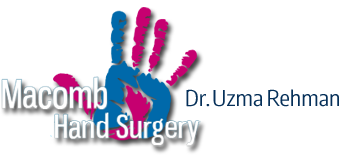How Hand Doctors Treat Thumb Arthritis
Arthritis of the thumb can be a source of significant pain and frustration for many individuals, impacting daily activities such as gripping objects, writing, and even simple tasks like turning a key or buttoning clothing. As the thumb joint wears down over time due to repetitive use or age-related degeneration, the cartilage that cushions the joint may deteriorate, leading to inflammation, stiffness, and discomfort. This can result in decreased mobility and functionality of the thumb, affecting overall hand function and quality of life.
If you suffer from thumb arthritis, you know how frustrating it can be to tackle simple everyday tasks, like opening a jar or buttoning a shirt. Fortunately, hand doctors have several non-surgical treatments as well as medications that can ease pain and help restore thumb function.
What is Thumb Arthritis?
The Carpometacarpal (CMC) joint – or basal joint – is the thumb joint nearest the palm. This is the joint used for the pivoting and pinching needed to grip things in your hand. Osteoarthritis in the carpometacarpal (CMC) is one of the conditions most frequently treated by hand doctors.
Osteoarthritis causes the cartilage in a joint to wear away. As a result, the shock and impact absorbing function of the cartilage is lost – causing the bones ton rub against each other. This causes stiffness and pain that can interfere with daily activities.
Symptoms of thumb arthritis include:
- Pain when performing activities that involve gripping or pinching,
- Swelling and tenderness at the base of the thumb,
- Ache or discomfort after prolonged use of the thumb
- Enlargement of the joint or a bony bump over the joint
- Limited motion of the thumb
Who Gets Thumb Arthritis?
Individuals who are at higher risk for developing thumb arthritis include those with a family history of the condition, as well as those who engage in activities that place repetitive stress on the thumb joint, such as typing, sewing, or playing musical instruments.
People older than age 40 are most at risk for thumb arthritis. And while both men and women can suffer from osteoarthritis in the thumb joint, it occurs five to 10 times more frequently in females. In fact, osteoarthritis in the hand is the second most common, after knee arthritis, in the United States.
Fractures or other injuries to the thumb joint also may increase the likelihood of developing this condition. Dr. Rehman may X-ray your thumb to determine the severity of the osteoarthritis. Keep in mind, however, that, but the x-ray findings do not necessarily correlate to the severity of symptoms.
How Hand Doctors Treat Thumb Arthritis Non-Invasively
Timely treatment of thumb arthritis by a hand doctor is essential to restore mobility and prevent or slow further joint damage. There are several non-surgical treatments that hand doctors use to ease pain and help restore function.
Fortunately, there are several treatment options available to help manage the symptoms of thumb arthritis and improve hand function. Conservative measures may include rest, activity modification, splinting, and over-the-counter pain medications to alleviate discomfort and reduce inflammation.
Icing the thumb joint for five to 15 minutes several times a day may help. Over the counter nonsteroidal anti-inflammatory medication (such as ibuprofen), anti-inflammation supplements (such as Arnica or Turmeric), heat packs, and/or topical arthritis creams may also help.
In some cases hand doctors may recommend a splints to provide some pain relief. Typically hand doctors prescribe a soft splint, similar to a biking glove, which has a strap to stabilize the thumb. Hard plastic splints may also help increase function in some situations.
If splinting doesn’t bring pain relief after a few months, the next treatment for thumb osteoarthritis typically involves steroid (cortisone) injections directly into the thumb joint. Most hand doctors believe that one or two injections are usually worth a try, because in many cases this will provide lasting relief.
Physical therapy exercises and hand strengthening exercises may also be recommended to help improve range of motion and joint stability. In more severe cases of thumb arthritis where conservative treatments are ineffective, surgical intervention may be necessary to alleviate pain and restore function. Procedures such as thumb joint fusion or joint replacement may be performed to reduce pain and improve thumb mobility.
How Hand Doctors Treat Thumb Arthritis with Surgery
If nonsurgical treatment is not effective, and the pain is overwhelming, Dr. Rehman many recommend surgery.
Ligament reconstruction and tendon interposition (LRTI) surgery can be very effective. Hand doctors have refined the techniques involved in this procedure a great deal over the last 50 years with great success.
During ligament reconstruction and tendon interposition (LRTI), the hand surgeon removes the trapezium tendon, and replaces it with a “spare” tendon from the forearm in order to stabilize the thumb. Hand doctors typically perform LRTI surgery on an outpatient basis. After LRTI surgery, patients typically wear a splint or cast for four to six weeks, followed by occupational therapy.
Hand doctors report that LRTI surgery provides about 95 percent pain relief and a 70 – 80% restoration of grip strength.
Top Wrist & Hand Doctor Clarkston, MI
At Macomb Hand Surgery in the Clarkston, MI area, our experienced hand surgeons specialize in the diagnosis and treatment of thumb arthritis, offering personalized care and comprehensive treatment options to help patients regain comfort and function in the fingers, thumb, and hands.
If you are experiencing hand, wrist or finger problems – including pain, numbness, stiffness or tingling, contact Clarkston board certified hand surgeon Doctor Rehman, for a comprehensive evaluation and consultation. As with most medical conditions, early detection, awareness, and a prevention or treatment plan is the most effective way to combat the effects of medical conditions including arthritis of the thumb.

